East Africa is a region blessed with a diverse range of birds, providing bird enthusiasts with an opportunity to indulge in their passion by observing and studying them.
From Kenya, Tanzania, Uganda, Rwanda, Burundi, and South Sudan, East Africa is home to over 1,400 bird species, including migrants and endemic species.
The region’s diverse habitats, including forests, wetlands, lakes, savannas, and coastal areas, support varied birdlife.
East Africa’s birdlife is also significant for its conservation benefits, contributing to the region’s ecological balance and maintaining its biodiversity.
This article aims to introduce the rich birdlife of East Africa and highlight its importance in the region.
1. Pied Kingfisher
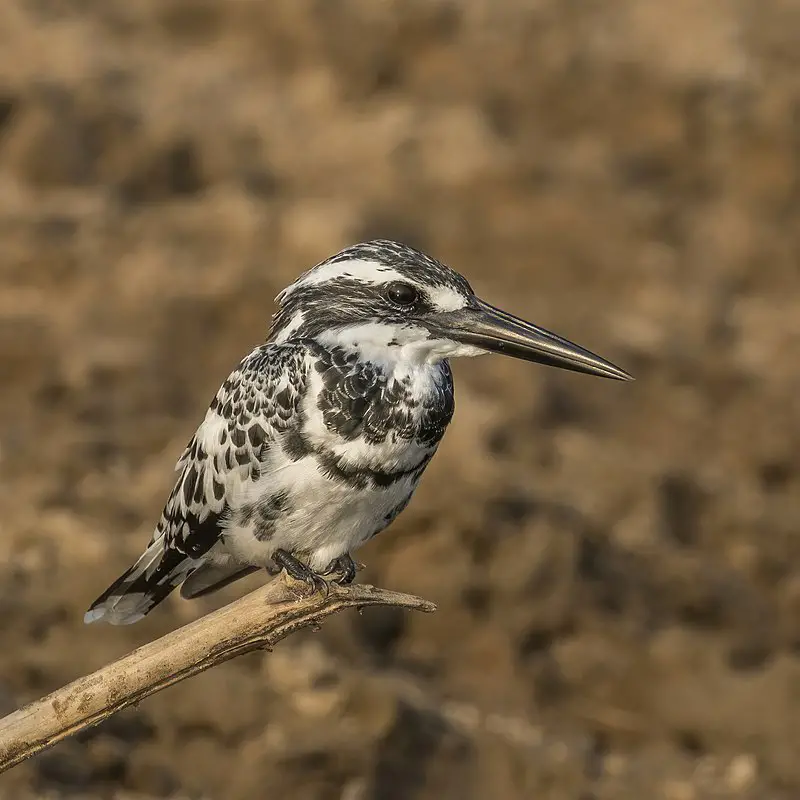
The Pied Kingfisher is a species of water kingfisher found in Africa and Asia. It has black and white plumage, with males sporting a double band across the breast while females have one single band.
This bird makes its presence known by hovering over clear waters before diving for fish – making it easily recognizable.
The diet consists mostly of small aquatic animals such as frogs, crustaceans, and insects, but they also consume some plant matter like seeds or fruits occasionally.
The pied kingfisher nests near bodies of water where it can feed off smaller creatures that dwell there; usually in burrows dug into riverbanks or on floating vegetation close to shorelines.
With their distinct colors and behavior patterns these birds make an interesting addition to any wildlife enthusiast’s list.
Scientific classification:
| Kingdom | Animalia |
| Phylum | Chordata |
| Class | Aves |
| Order | Coraciiformes |
| Family | Alcedinidae |
| Subfamily | Cerylinae |
| Genus | Ceryle F. Boie, 1828 |
| Species | C. rudis |
Also Featured In: Native Pakistani Birds, Lebanon Birds Live in Semi-Desert Areas
2. Hamerkop
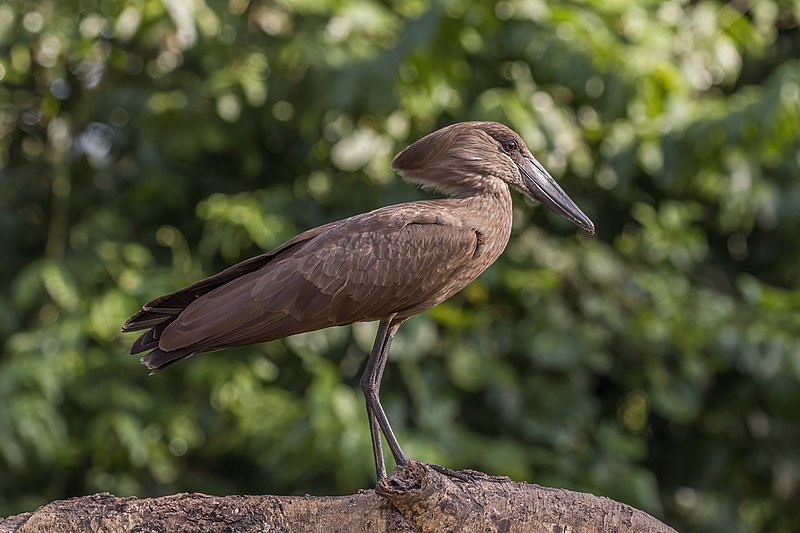
The Hamerkop is a unique wading bird found across sub-Saharan Africa and as far east as India.
It has an unmistakable silhouette, with its long bill topped by a crest at the back of its head that gives it the look of a hammerhead shark.
Its plumage consists mainly of browns and greys, providing excellent camouflage in reed beds.
The species was once classified alongside storks but is now believed to be closely related to pelicans and shoebills instead.
This medium-sized bird feeds on insects, fish, frogs, or small reptiles which it captures from shallow water or plucks from trees near bodies of water.
Despite being considered ‘unlucky’ by some cultures due to superstition surrounding their appearance they are actually quite important for controlling populations of certain pests.
Scientific classification:
| Kingdom | Animalia |
| Phylum | Chordata |
| Class | Aves |
| Order | Pelecaniformes |
| Family | Scopidae |
| Genus | Scopus |
| Species | S. umbretta |
Also Featured In: Common Nigerian Birds, Chad Birds You Didn’t Know
3. Augur Buzzard
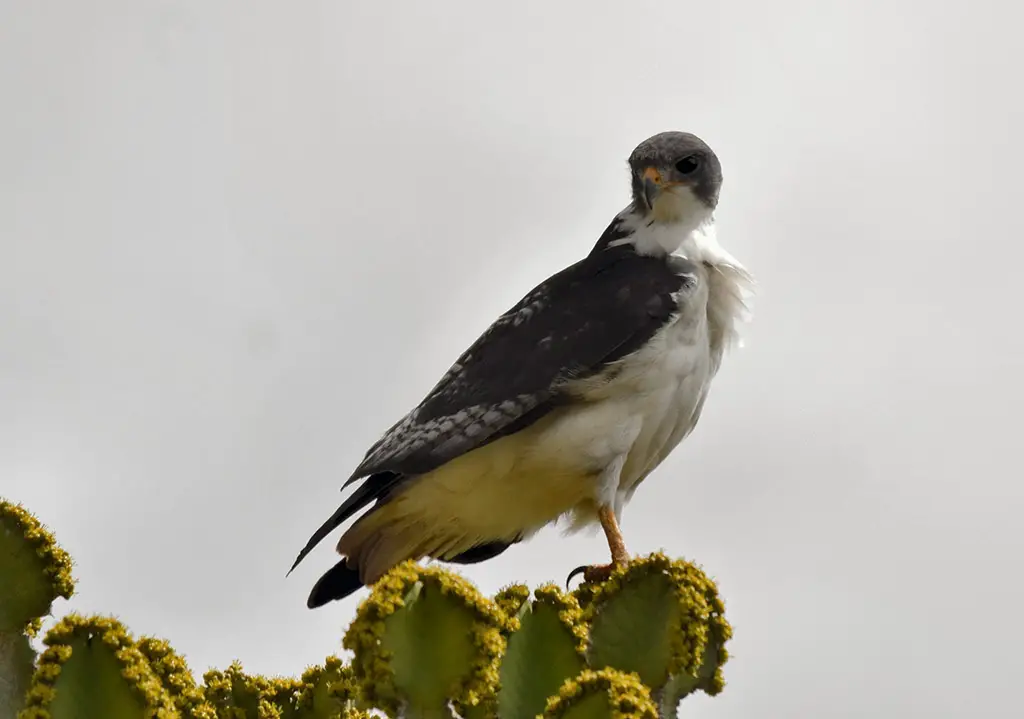
The Augur Buzzard is an impressive African bird of prey, typically identified by its blackish back and wings, white underside, and orange-red tail. A dark morph also exists for this species while juveniles are usually brown in colour.
It is found throughout Central and Southern Africa where it inhabits a variety of habitats ranging from grasslands to wooded savannas.
This Buteo genus member has a wide range of food sources including rodents, reptiles, insects, and other birds making it quite versatile when hunting for sustenance.
Its powerful talons allow the buzzard to snatch up large prey with ease ensuring that meals are never far away. Scientific classification:
| Kingdom | Animalia |
| Phylum | Chordata |
| Class | Aves |
| Order | Accipitriformes |
| Family | Accipitridae |
| Genus | Buteo |
| Species | B. augur |
Also Featured In: Common Ethiopian Birds, Birds that Ngorongoro Crater
4. Hoopoes
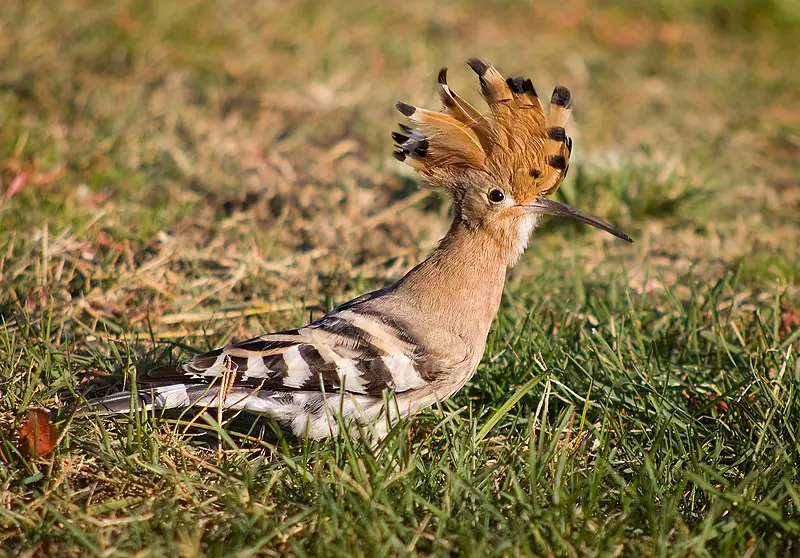
Hoopoes are a fascinating species of bird, found across Africa, Asia and Europe. They have beautiful plumage with unique ‘crowns’ of feathers on their heads.
Three living and one extinct species exist – although for some time they were all classed as the same species: Upupa epops. Some taxonomists still believe this to be true.
These birds are often associated with royalty due to the impressive crown-like crest atop their head, adding an extra element of mystery and exoticism to these creatures.
Hoopoes can also produce loud calls which sound like “hoo-poo” hence why they’ve been given such an apt name.
Scientific classification:
| Kingdom | Animalia |
| Phylum | Chordata |
| Class | Aves |
| Order | Bucerotiformes |
| Family | Upupidae Leach, 1820 |
| Genus | Upupa Linnaeus, 1758 |
Also Featured In: Egyptian Birds, Turkey Birds You Should Know
5. Egyptian Goose
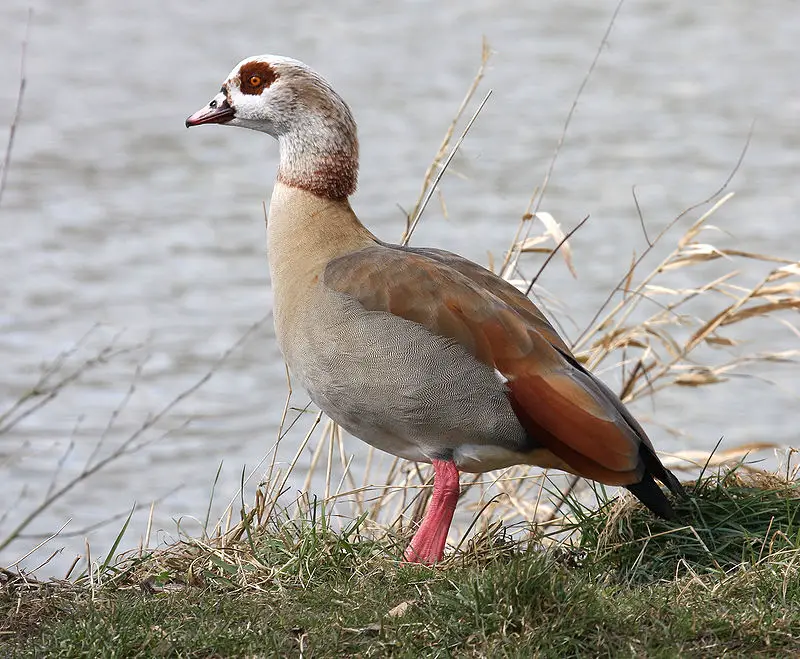
The Egyptian goose is a beautiful bird from the Anatidae family native to Africa. It has long been revered by the Ancient Egyptians, who depicted it in much of their artwork.
Today, these geese are kept as ornamental birds and commonly escape into the wild, resulting in an abundance of feral populations across the southern Sahara and Nile Valley regions.
Its grayish-brown body features white patches around its neck and tail feathers that range from dark brown to bluish-grey coloration.
This species stands out amongst other waterfowls with its striking appearance which also features bold orange eyes surrounded by blue eye rings – quite remarkable.
As they swim along rivers or roam grasslands searching for food such as grains, fruits & vegetables; they make great additions to both aviary collections and natural habitats alike.
Scientific classification:
| Kingdom | Animalia |
| Phylum | Chordata |
| Class | Aves |
| Order | Anseriformes |
| Family | Anatidae |
| Genus | Alopochen |
| Species | A. aegyptiaca |
Also Featured In: Amsterdam Birds You Should Know, Birds You’ll Find in Kenya Safari
6. Crab-Plover
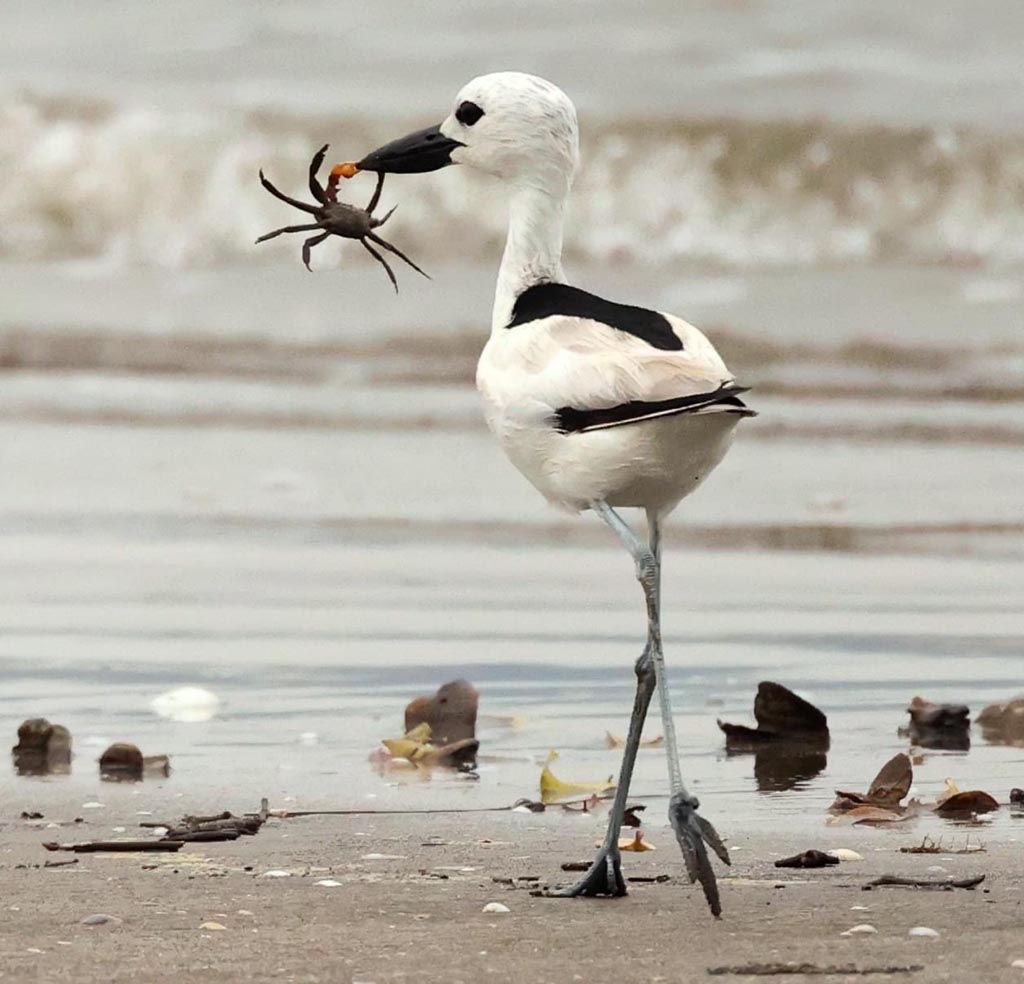
The crab-plover is an exceptional bird that belongs to its own family, Dromadidae. It appears to be closely related to the waders and other Charadriiformes such as auks, gulls, and thick-knees.
This species of bird has a unique look; it is white with black markings on its head and wings. Its long bill helps them dig for food in sand or mudflats.
They can also fly up into the air when disturbed by predators or people too close for comfort.
The crab plover spends most of its life near beaches where they feed on crabs, fish eggs, and small insects found there.
These birds are highly social during breeding season but solitary at other times throughout their annual cycle making them difficult creatures to spot out in the wild but well worth trying.
Scientific classification:
| Kingdom | Animalia |
| Phylum | Chordata |
| Class | Aves |
| Order | Charadriiformes |
| Suborder | Lari |
| Family | Dromadidae GR Gray, 1840 |
| Genus | Dromas Paykull, 1805 |
| Species | D. ardeola |
Also Featured In: Birds That Live in Iraq, Syrian Birds You Need to Know
7. Great Cormorant
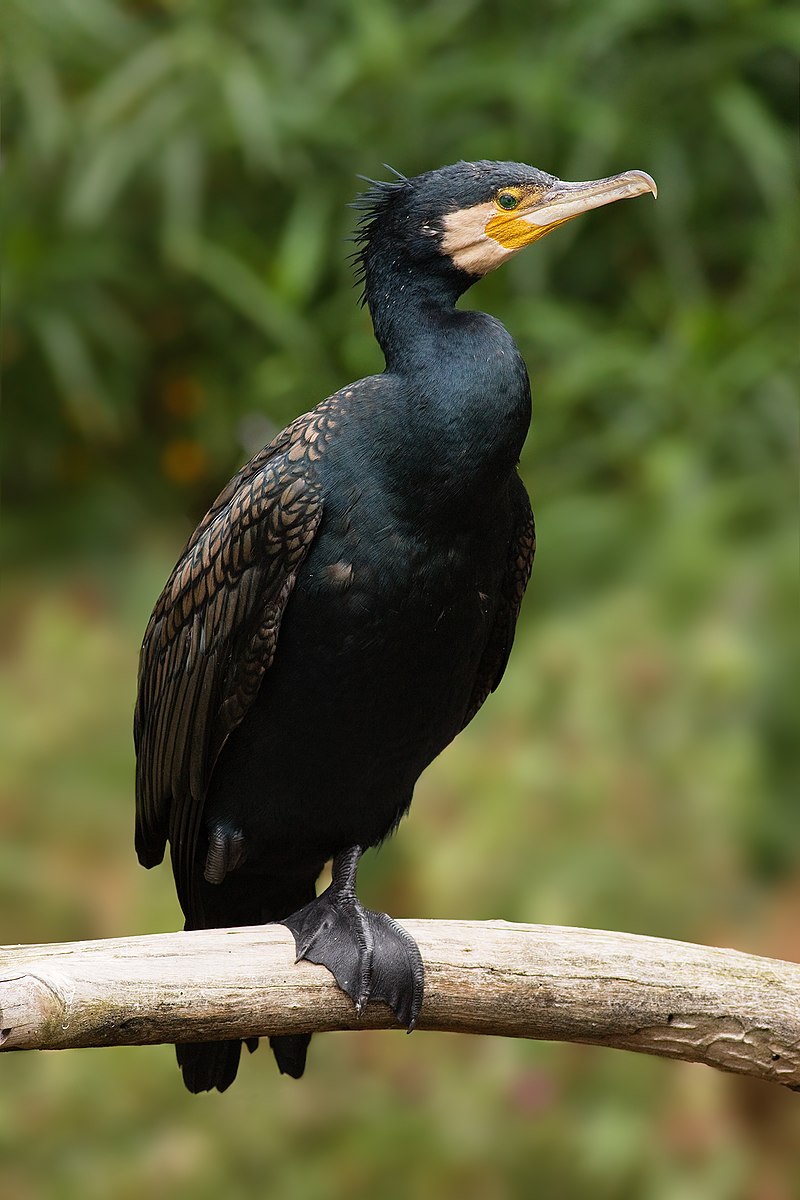
The Great Cormorant is a large seabird belonging to the Cormorant family. It has many names, including Black Shag in New Zealand and Large Cormorant in India.
Its striking black feathers make it easy to recognize along coastlines or near bodies of water. The bird can measure up to 1 meter long with a wingspan of around two metres and weighs roughly 3 kilograms.
In flight, its neck is stretched out straight ahead while its bill points downwards – an unmistakable sight for any keen observer.
Cormorants are strong swimmers and excellent divers, frequently going underwater in search of food such as fish or crustaceans that they scavenge from the ocean floor.
They live primarily on coasts but have also been seen inland where there are suitable waterways available – providing another opportunity for nature lovers hoping to catch a glimpse of this impressive species.
Scientific classification:
| Kingdom | Animalia |
| Phylum | Chordata |
| Class | Aves |
| Order | Suliformes |
| Family | Phalacrocoracidae |
| Genus | Phalacrocorax |
| Species | P. carbo |
Also Featured In: Native Birds Of Germany, Water Birds Live around Us
8. Lilac-Breasted Roller
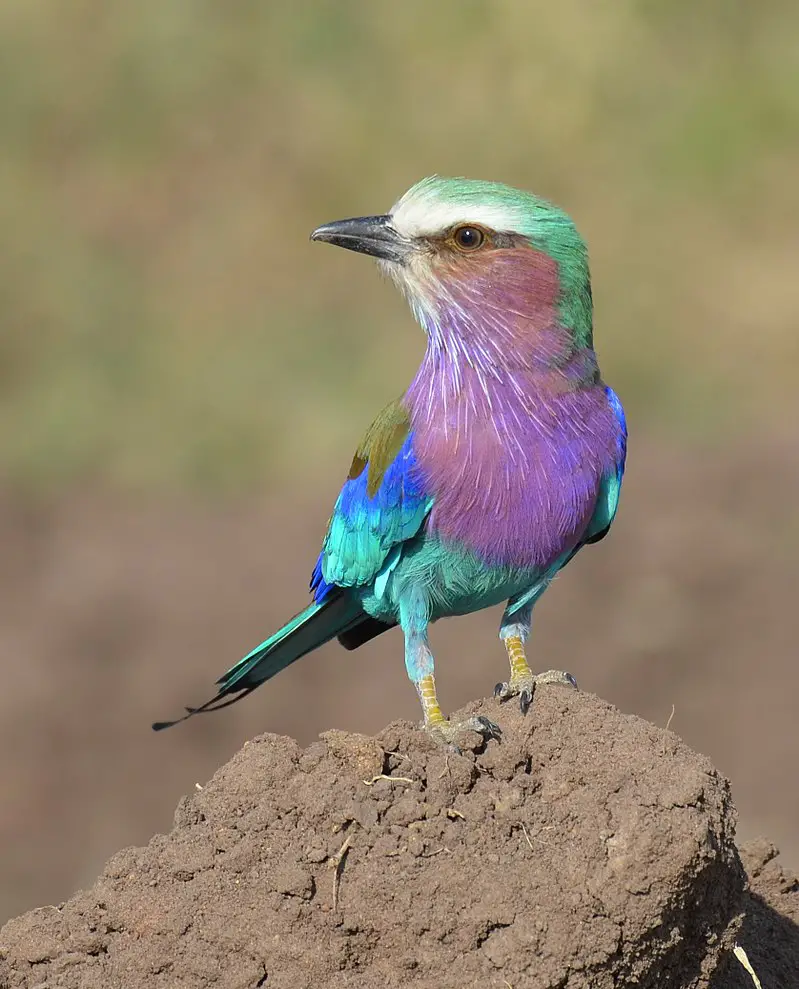
The Lilac-breasted Roller is a spectacular bird native to Southern and Eastern Africa, with occasional appearances in the southern Arabian Peninsula.
With its bright purple chest plumage and distinct black stripes on its wings and tail feathers, it stands out among birds of the same family.
It is usually found alone or in pairs perched atop trees or other high viewpoints, often used as lookout points for predators.
This species prefers open areas such as woodlands and savannas; it avoids treeless places like deserts due to their lack of protection from potential dangers.
Its call is loud and melodious – an unmistakable sound echoing through African skies.Scientific classification:
| Kingdom | Animalia |
| Phylum | Chordata |
| Class | Aves |
| Order | Coraciiformes |
| Family | Coraciidae |
| Genus | Coracias |
| Species | C. caudatus |
Also Featured In: Birds of Tanzania, Famous Paintings Birds
9. Kori Bustard
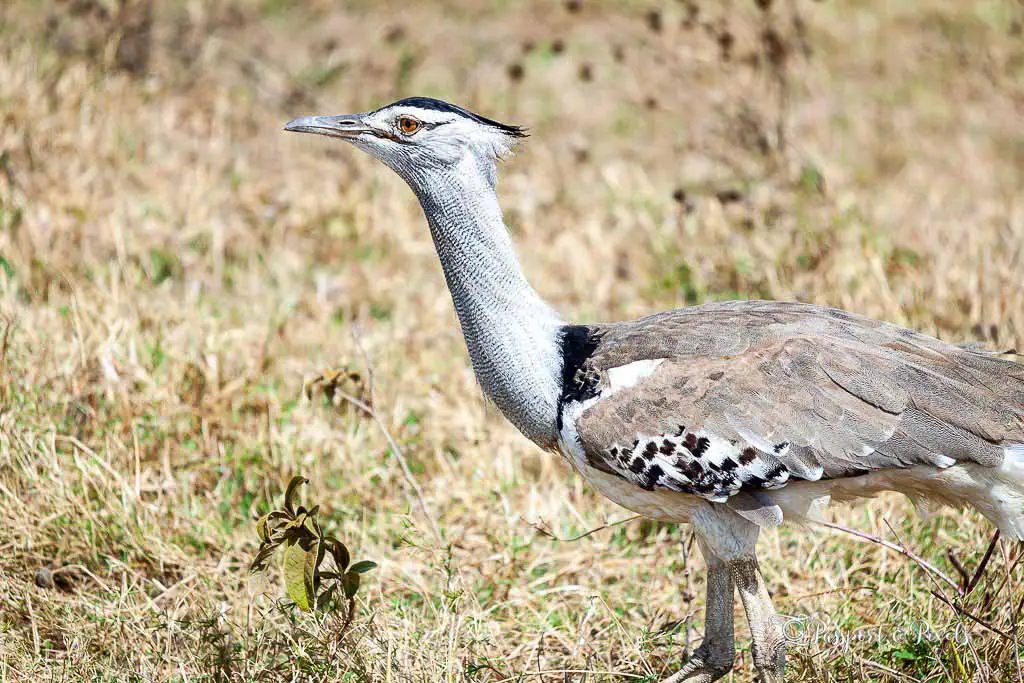
The Kori Bustard is the largest flying bird native to Africa and part of the Bustard family. It has a large body, with males reaching up to 20kg in weight – making it one of the heaviest living animals capable of flight.
Its range covers most African countries from Ethiopia all the way down south towards South Africa.
The Kori Bustard is omnivorous and feeds on insects, small lizards, seeds, fruit, and even carrion if available.
Their feathers are mostly brownish grey while their heads have black stripes running over them which makes them easily identifiable when seen in their natural habitat.
They usually live alone or in pairs during breeding season but will gather into larger groups at other times throughout their lives; typically nesting on dry open grasslands near water sources for easy access to food and drink.
Scientific classification:
| Kingdom | Animalia |
| Phylum | Chordata |
| Class | Aves |
| Order | Otidiformes |
| Family | Otididae |
| Genus | Ardeotis |
| Species | A. kori |
Also Featured In: Birds that You’ll Find in Kruger national park, Birds of Etosha National Park
10. Silvery-Cheeked Hornbill
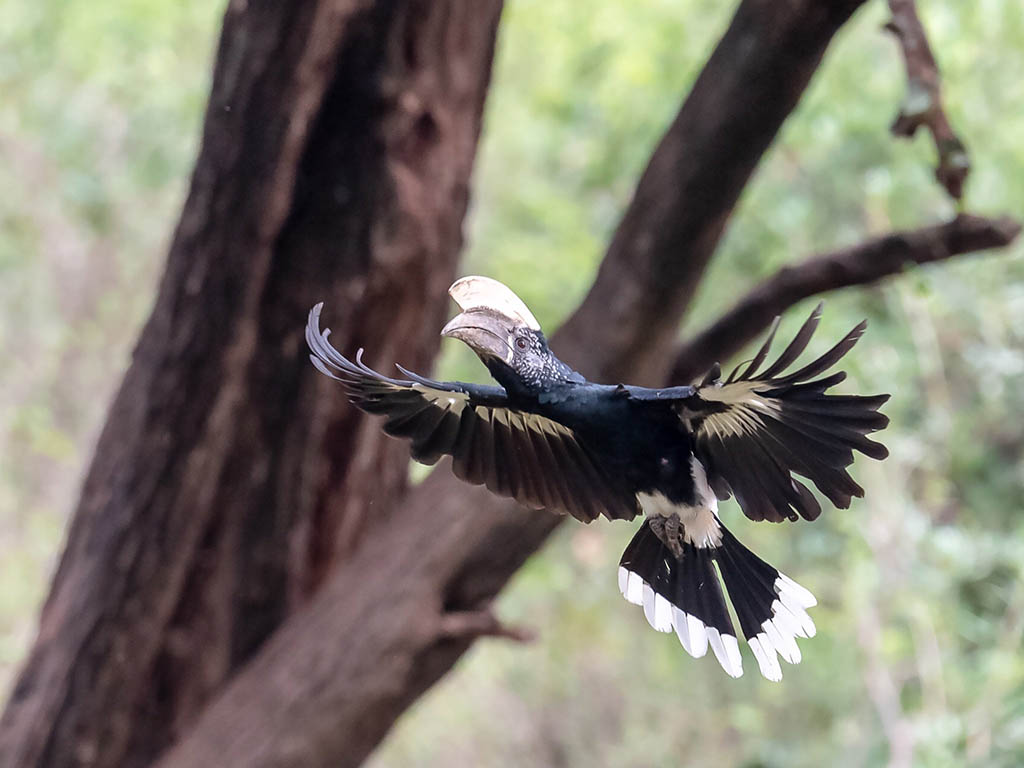
The silvery-cheeked hornbill is a beautiful species of bird native to East Africa. It stands out in its habitat due to its large size and striking features, including bright yellow eyes and white cheek patches on either side of the head.
This impressive creature can be found inhabiting tall evergreen forests from Ethiopia all the way down to South Africa.
Unfortunately, it’s becoming threatened as deforestation destroys more areas that are suitable for nesting sites.
Despite this threat, these birds remain fairly common throughout Zimbabwe and northern/central parts of South Africa – however their presence there is marginal at best.
We must work together now if we want future generations to have the chance to appreciate these magnificent creatures.
Scientific classification:
| Kingdom | Animalia |
| Phylum | Chordata |
| Class | Aves |
| Order | Bucerotiformes |
| Family | Bucerotidae |
| Genus | Bycanistes |
| Species | B. brevis |
Also Featured In: Silver Birds You Should Know,
11. Yellow-billed stork
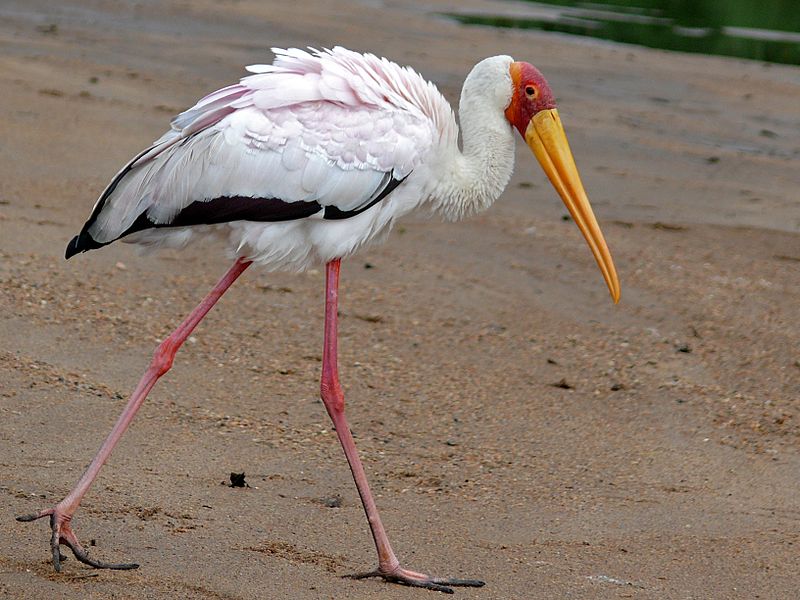
The yellow-billed stork is a large wading bird found in Africa south of the Sahara as well as Madagascar.
It belongs to the family Ciconiidae and has three other species in its genus – Mycteria americana, Mycteria cinerea, and Leptoptilos javanicus.
This majestic bird stands at an average height of up to 1 meter with a wingspan that can reach 2 meters wide.
Its plumage is predominantly white with black flight feathers that contrast against its bright yellow bill after which it is named.
The Yellow-billed Stork feeds on fish, frogs, insects, and small reptiles like snakes by probing deep into mud or shallow water bodies using its long beak.
These captivating birds are also known to form colonies during their nesting season from August until October where they build nests out of sticks atop tall trees near wetlands or riversides.
Scientific classification:
| Kingdom | Animalia |
| Phylum | Chordata |
| Class | Aves |
| Order | Ciconiiformes |
| Family | Ciconiidae |
| Genus | Mycteria |
| Species | M. ibis |
Also Featured In: Large African Birds You Need to Know, Fuerteventura Island Birds You Need to See
12. Black-Headed Heron
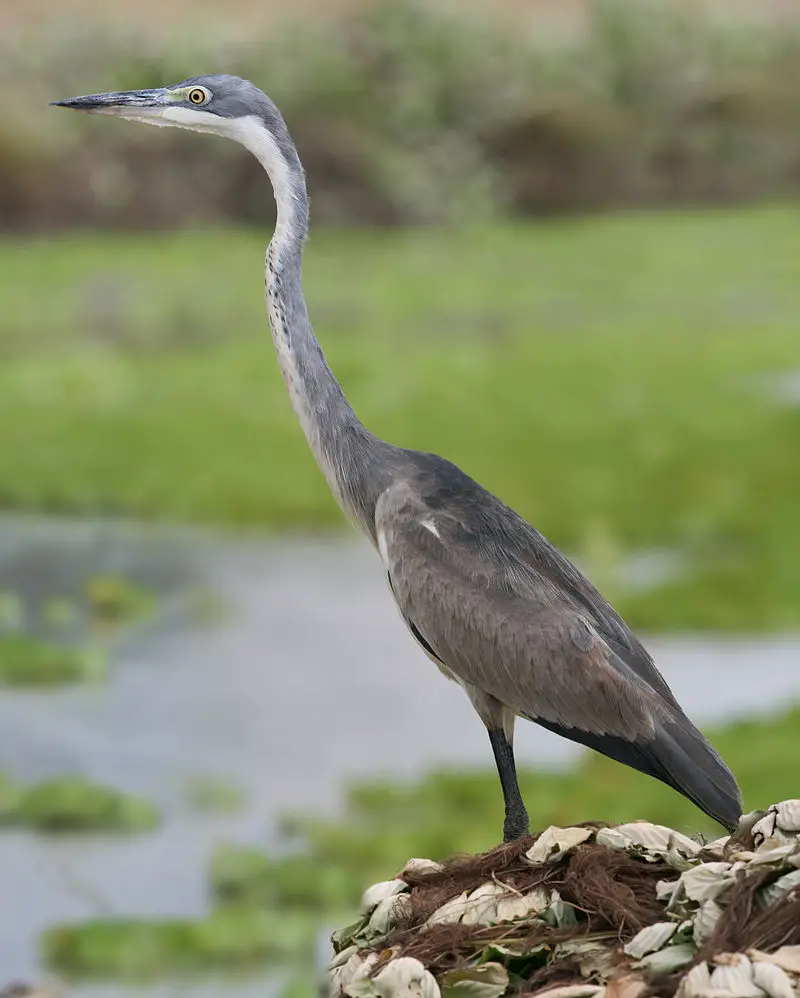
The Black-headed Heron is a wading bird from the heron family Ardeidae, found in sub-Saharan Africa and Madagascar.
It typically resides in wetland areas such as reedbeds or swamps but some birds migrate further north during rainy seasons.
Breeding usually takes place between two to four eggs laid within a bulky stick nest built by both parents.
The Black-headed Heron feeds mainly on small fish, crustaceans, and other aquatic organisms which it catches with its long bill while standing still at the water’s edge or slowly moving around shallow waters.
Its feathers are usually mostly white apart from the black head for which this species has been named and grey wings with distinctive dark patches near the shoulder area giving them an attractive appearance when seen up close.
Scientific classification:
| Kingdom | Animalia |
| Phylum | Chordata |
| Class | Aves |
| Order | Pelecaniformes |
| Family | Ardeidae |
| Genus | Ardea |
| Species | A. melanocephala |
13. White-Backed Vulture
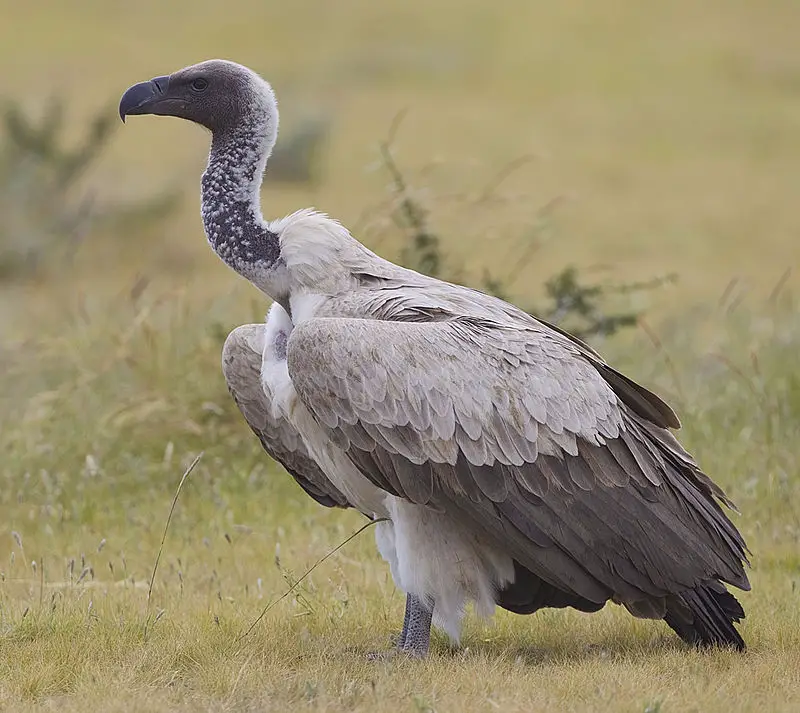
The White-backed Vulture, or Gyps africanus, is a species of Old World vulture that inhabits the African continent.
It has distinct features including down feathers on its head and neck as well as a white ruff around its neck. Its wings are broad and its tail short.
This distinctive bird is primarily found in open habitats such as grasslands, savannahs, woodlands, and wetlands where it feeds mainly on carrion from animals like wildebeests and zebras killed by other predators.
The White-backed Vulture plays an important role in maintaining balance within the food chain by helping to clean up carcasses left behind by larger carnivores which helps to reduce diseases caused by decaying matter while providing vital nutrients for scavenging birds like itself.
Scientific classification:
| Kingdom | Animalia |
| Phylum | Chordata |
| Class | Aves |
| Order | Accipitriformes |
| Family | Accipitridae |
| Genus | Gyps |
| Species | G. africanus |
Also Featured In: Scavengers Birds You Should Know,
14. Malachite Kingfisher
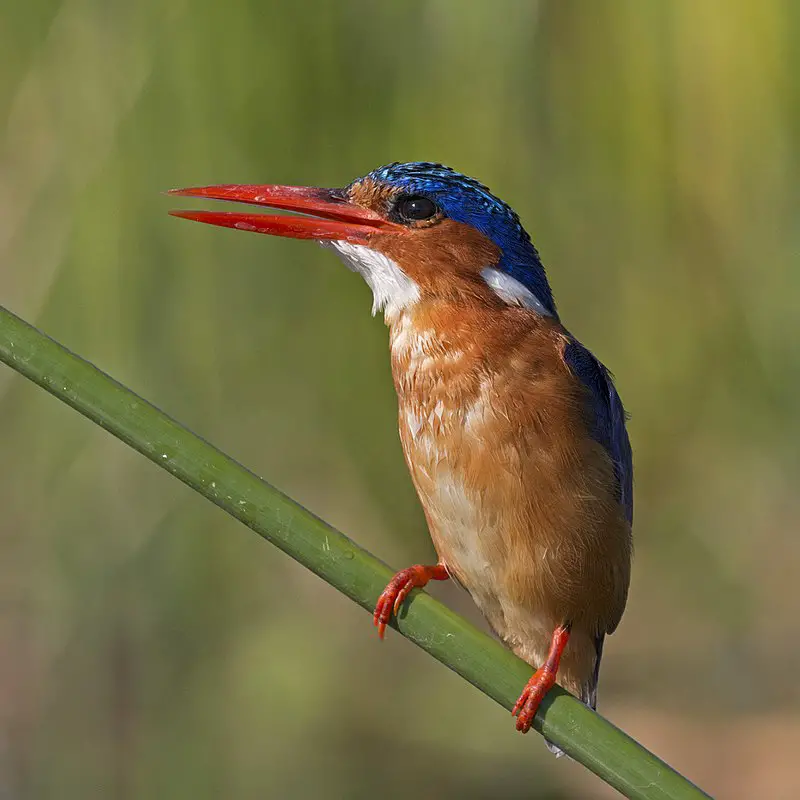
The Malachite Kingfisher is a beautiful bird found in Africa south of the Sahara. It has bright blue wings and tail, with greenish-black upperparts, white chin and breast and orange lower belly.
The species was first described by German naturalist Peter Simon Pallas in 1764 who gave it its binomial name “Alcedo cristata”.
This kingfisher typically inhabits rivers where it feeds on fish, frogs as well as aquatic invertebrates like crustaceans and insects.
Although mainly resident throughout the year, some do make seasonal movements due to climate changes.
These birds are monogamous during breeding season which usually lasts from August till October when they build their nests inside river banks or overhanging vegetation near water bodies.Scientific classification:
| Kingdom | Animalia |
| Phylum | Chordata |
| Class | Aves |
| Order | Coraciiformes |
| Family | Alcedinidae |
| Subfamily | Alcedininae |
| Genus | Corythornis |
| Species | C. cristatus |
Also Featured In: Birds that Live in lake Mburo National Park,
15. Crowned Lapwing
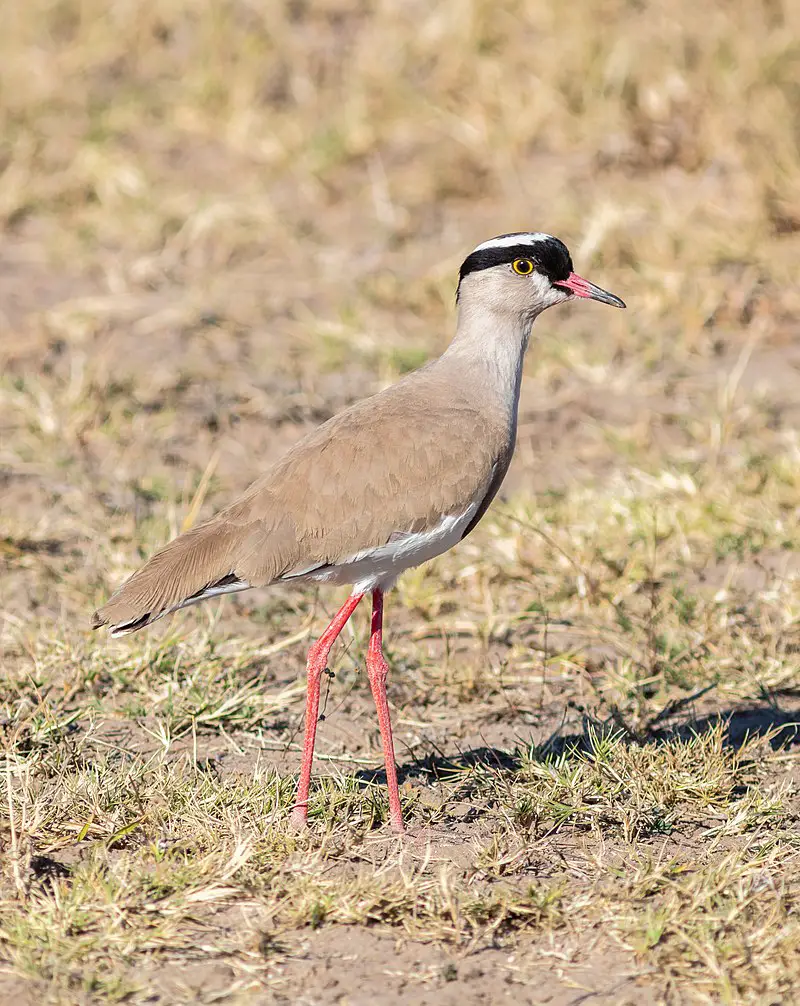
The crowned lapwing is a striking bird of the subfamily Vanellinae, found in many parts of Africa. Their most distinctive feature is their bright and attractive crown-shaped crest on the head.
They typically have brown plumage with white spots over the wings and tail, as well as yellow legs and beaks.
These birds are known for being quite vocal; they make loud calls to communicate with one another or warn predators away from their nests.
Crowned lapwings can live up to 10 years in captivity but usually only survive 1–2 years in the wild due to predation by other animals such as cats, dogs, snakes, and hawks.
Despite this mortality rate, these birds remain common throughout much of Africa thanks to their adaptability and ability to nest near humans without conflict.
Scientific classification:
| Kingdom | Animalia |
| Phylum | Chordata |
| Class | Aves |
| Order | Charadriiformes |
| Family | Charadriidae |
| Genus | Vanellus |
| Species | V. coronatus |
16. Grey Crowned Crane
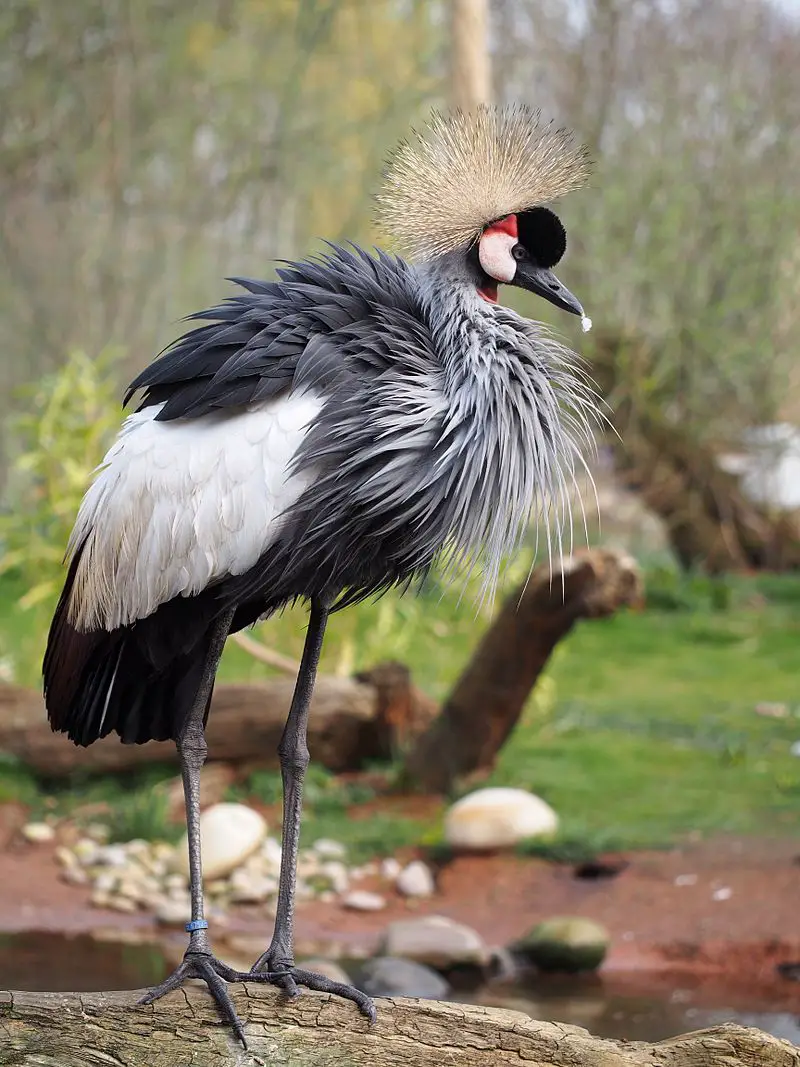
The Grey Crowned Crane is a beautiful bird native to eastern and southern Africa. It belongs to the crane family, Gruidae, and its stunning plumage consists of grey feathers topped with golden crowns on their heads.
This species has become Uganda’s national bird due to its gracefulness in flight as well as for being an important part of local cultures across the continent.
The Grey Crowned Crane stands out from other birds not only because of its colorful appearance but also because it performs elaborate mating dances involving leaps, bows, throwing their head back or flapping wings while calling loudly – all in an effort to attract a mate.
In addition to these displays, they are highly social animals that form strong bonds with one another and can live up to 20 years if given proper care.
Scientific classification:
| Kingdom | Animalia |
| Phylum | Chordata |
| Class | Aves |
| Order | Gruiformes |
| Family | Gruidae |
| Genus | Balearica |
| Species | B. regulorum |
Also Featured In: Birds of South African, Birds You’ll Find in Zoo
17. Saddle-Billed Stork
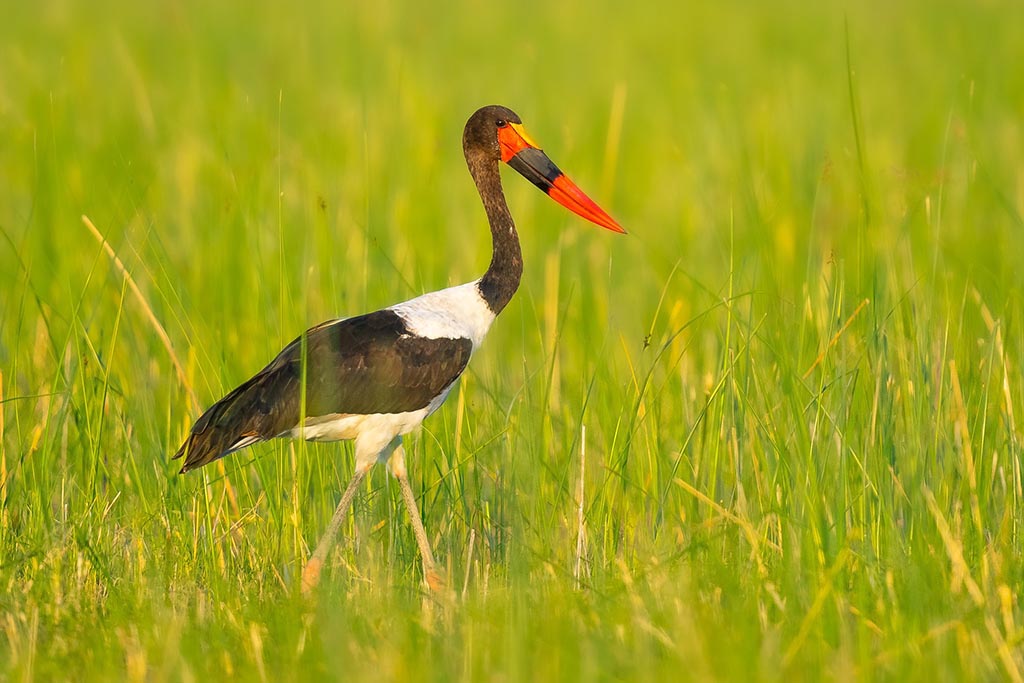
The Saddle-billed Stork is a large wading bird from the stork family, Ciconiidae. It can be found in sub-Saharan Africa and some parts of western Africa.
This majestic bird stands out with its striking features – it has an impressive bill that looks like a saddle and bright red legs which contrast against its white plumage on top.
The Saddle-billed Stork’s diet consists mostly of fish, frogs, aquatic invertebrates as well as small reptiles or mammals they come across while scavenging for food in wetland areas.
Sadly, this species is considered endangered in South Africa due to habitat loss and degradation caused by human activities such as drainage projects and agricultural expansion.
We must take action to protect these beautiful creatures before their numbers decrease further.
Scientific classification:
| Kingdom | Animalia |
| Phylum | Chordata |
| Class | Aves |
| Order | Ciconiiformes |
| Family | Ciconiidae |
| Genus | Ephippiorhynchus |
| Species | E. senegalensis |
Also Featured In: Big Birds that Live in Uganda, Large Birds of Uganda
18. Rüppell’s Vulture
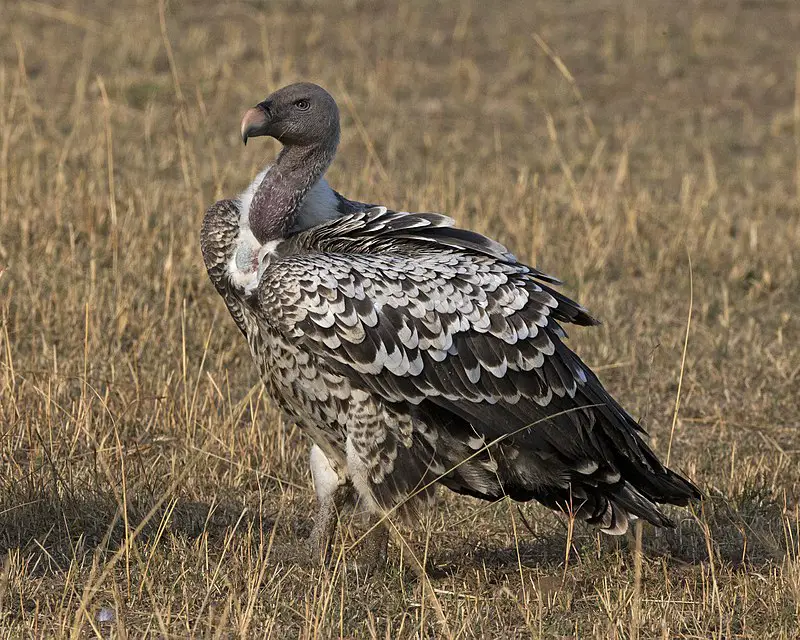
Rüppell’s vulture is a large bird of prey native to the Sahel region and East Africa, named after Eduard Rüppell.
It has a current population of around 22,000 but its numbers are decreasing due to loss of habitat, accidental poisoning, and other factors.
This species can be identified by their dark brown bodies with white patches on their wings and black feathers at the base of their neck that form an “M” pattern.
They have grayish-white heads with yellow eyes surrounded by bare skin colored pink or red depending upon age/sex.
Their strong feet enable them to hold onto food while they tear it apart using powerful hooked beaks which also help them scavenge for carrion in open grasslands or savanna habitats where they primarily feed off dead animals.
Scientific classification:
| Kingdom | Animalia |
| Phylum | Chordata |
| Class | Aves |
| Order | Accipitriformes |
| Family | Accipitridae |
| Genus | Gyps |
| Species | G. rueppelli |
Also Featured In: Common Kenyan Birds, Flight Birds You Should Know
19. Marabou Stork
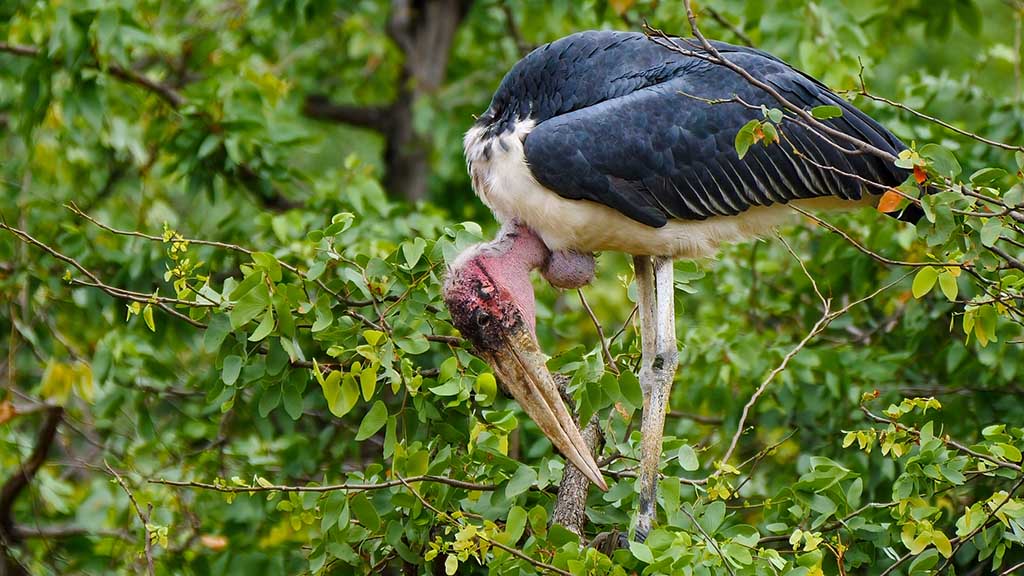
The marabou stork is a large wading bird native to sub-Saharan Africa. It has an unmistakable appearance, with cloak-like wings and back, skinny white legs and sometimes a large mass of “hair”.
They reside in both wet and arid habitats near human habitation, often found at landfill sites.
This species has earned the nickname ‘undertaker bird’ due to its unique shape viewed from behind.
Despite living alongside humans they remain elusive birds who rarely interact with us but can still be seen gliding on thermals or standing majestically by lakesides.
The marabou stork is truly an impressive sight that will stay in your memory forever.Scientific classification:
| Kingdom | Animalia |
| Phylum | Chordata |
| Class | Aves |
| Order | Ciconiiformes |
| Family | Ciconiidae |
| Genus | Leptoptilos |
| Species | L. crumenifer |
20. Yellow-Billed Oxpecker
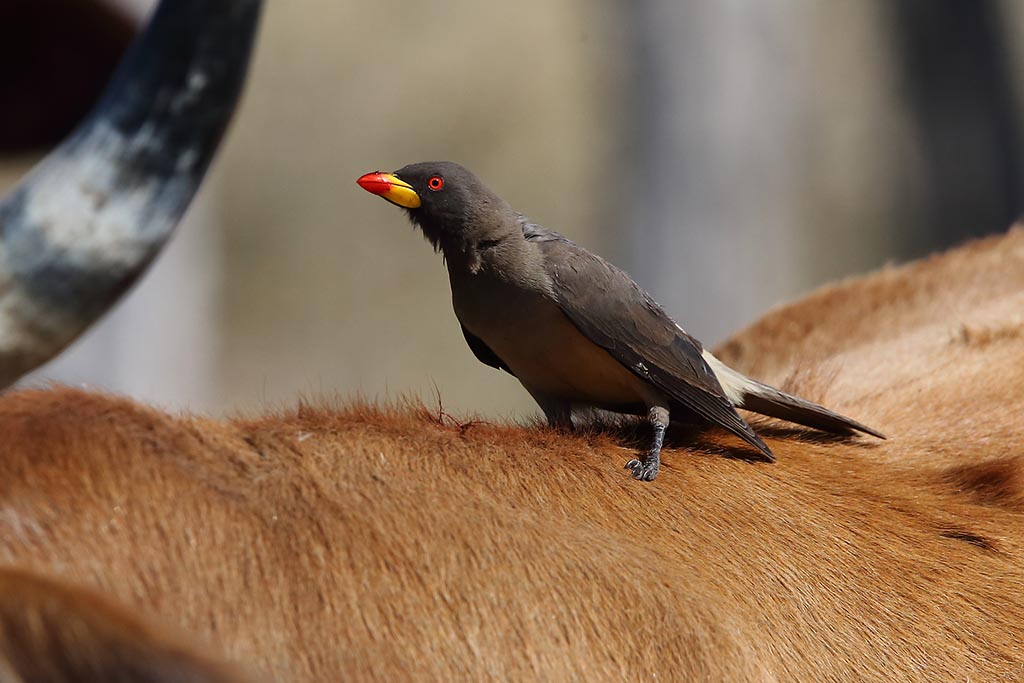
The Yellow-billed Oxpecker is a passerine bird native to the savannahs of Sub-Saharan Africa. It was previously placed in the Starling and myna family, Sturnidae.
These birds are characterized by their bright yellow bills, which give them their name.
They feed mainly on insects found on large mammals such as wildebeests and zebras but also consume fruits from nearby trees or shrubs when available.
The species tends to dominate over its smaller relative -the Red-billed oxpecker – whenever they share feeding grounds together; although it is least common in eastern parts of its range where they overlap with each other’s territories.
All in all, this beautiful avian creature makes for an interesting sight while exploring the African Savannah.
Scientific classification:
| Kingdom | Animalia |
| Phylum | Chordata |
| Class | Aves |
| Order | Passeriformes |
| Family | Buphagidae |
| Genus | Buphagus |
| Species | B. africanus |
Also Featured In: Uganda Birds Species,
21. Goliath Heron
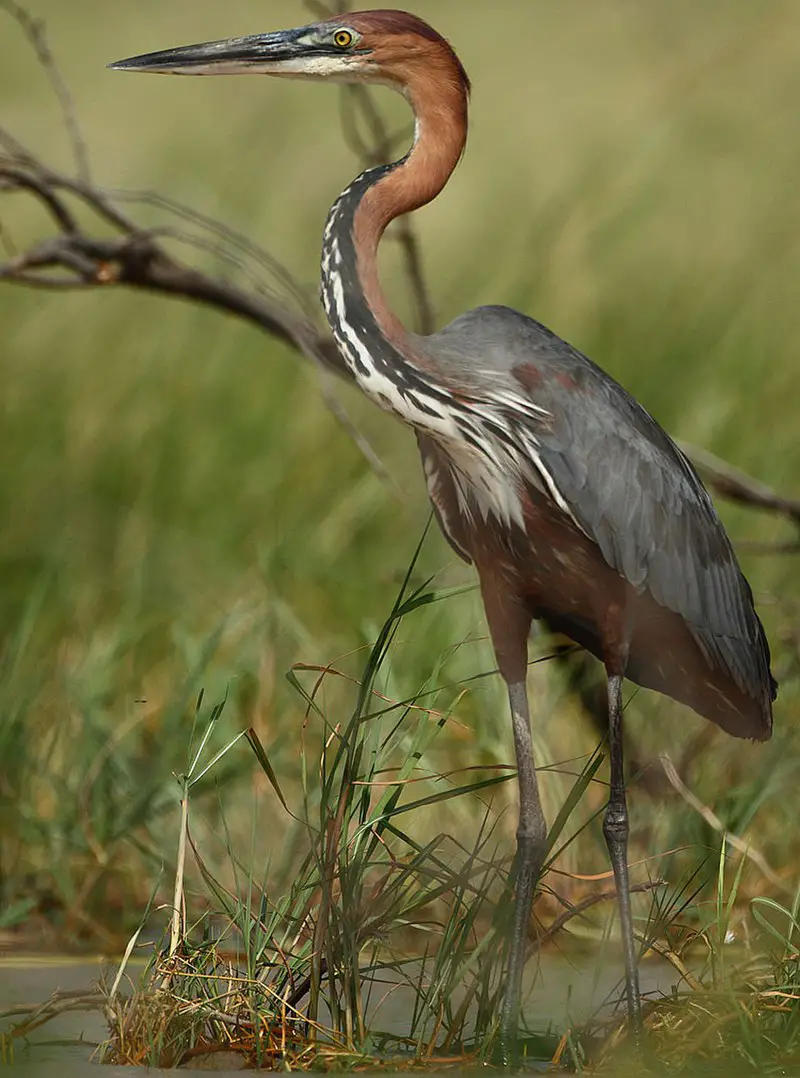
The Goliath Heron is the world’s largest living heron species, found in sub-Saharan Africa and in smaller numbers in Southwest and South Asia. It stands up to 5 feet tall with a wingspan of over 6 feet wide.
Its bill is long and yellowish-orange while its head has white plumes that point backward along its neck. Its back, scapulars, and tail feathers are dark gray or black while it has lighter gray wing coverts and primaries.
The body plumage ranges from light grey to brownish grey depending on age; younger birds have more whitish coloration than adults do.
This bird preys on fish as well as amphibians, crustaceans, insects, reptiles, and small mammals near water sources such as wetlands or lakesides it also visits agricultural land for carrion at times.
Scientific classification:
| Kingdom | Animalia |
| Phylum | Chordata |
| Class | Aves |
| Order | Pelecaniformes |
| Family | Ardeidae |
| Genus | Ardea |
| Species | A. goliath |
22. Crowned Cranes
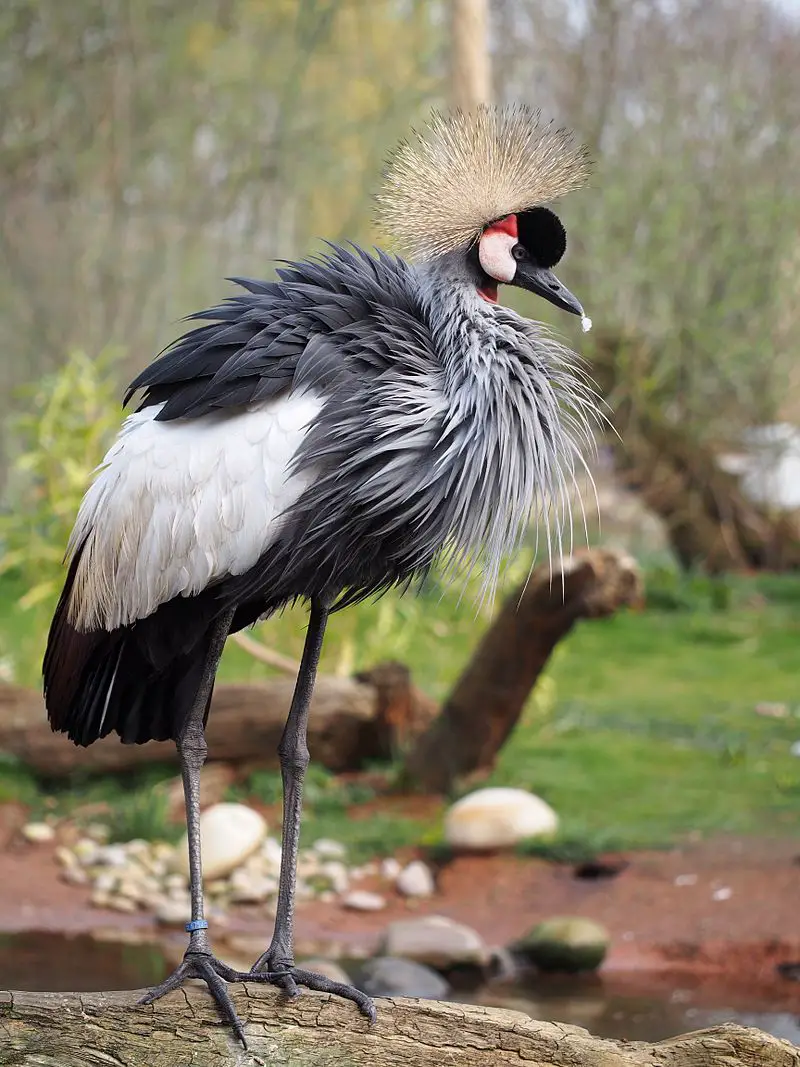
Crowned cranes, of the genus Balearica, are two species of birds in the crane family Gruidae. Found exclusively south of the Sahara Desert in Africa, they have adapted to nest in trees which sets them apart from other cranes that typically build on land.
The black crowned crane (B. pavonina) and grey crowned crane (B. regulorum) are both beautiful birds with unique feather patterns that distinguish them from each other; as well as a variety of calls used for communication between mates or flocks during migration.
They feed primarily on insects and grains but will also consume small animals such as frogs when available- making them omnivorous creatures.
Overall these gorgeous feathered friends make an important contribution to their ecosystems by helping keep populations balanced through their diet choices – truly majestic creatures indeed.
Scientific classification:
| Kingdom | Animalia |
| Phylum | Chordata |
| Class | Aves |
| Order | Gruiformes |
| Family | Gruidae |
| Subfamily | Balearicinae |
| Genus | Balearica Brisson, 1760 |
23. Fox’s Weaver
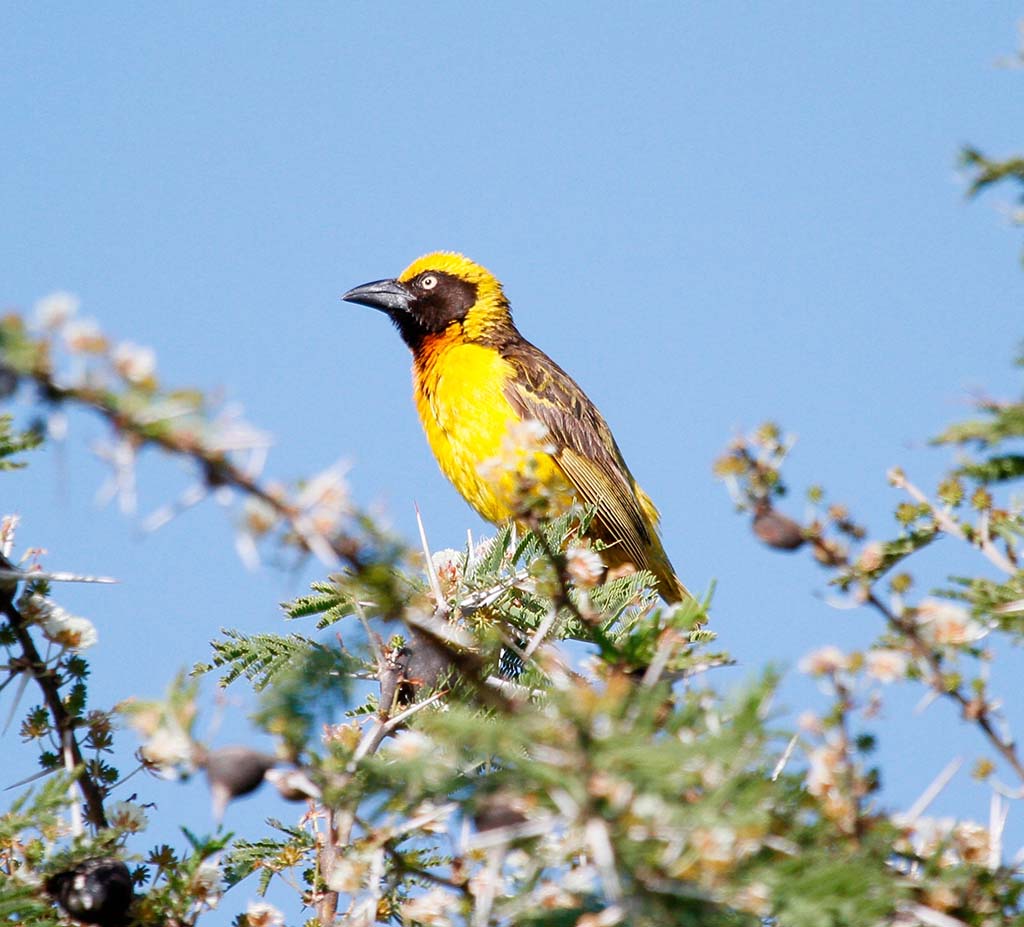
Fox’s weaver is a species of bird that can only be found in Uganda. As it lives in moist savanna, subtropical or tropical seasonally wet or flooded lowland grasslands, and swamps its habitat has become threatened by the loss of such environments due to human activities.
It belongs to the family Ploceidae which consists mostly of seed-eating birds with specialized bills for handling their food commodities.
This particular type of weaver stands out as it builds intricate nests made from leaves woven together using its long bill along with other materials like spider webs, small twigs, and bark strips making them look quite unique compared to those built by other types of birds within this family group.
Fox’s Weaver is certainly an amazing creature but unfortunately continues to face threats today so conservation efforts must continue if these beautiful creatures are going to survive.
Scientific classification:
| Kingdom | Animalia |
| Phylum | Chordata |
| Class | Aves |
| Order | Passeriformes |
| Family | Ploceidae |
| Genus | Ploceus |
| Species | P. spekeoides |
Also Featured In: Endemic Birds of Uganda that You Need to Know,
24. Eastern Imperial Eagle
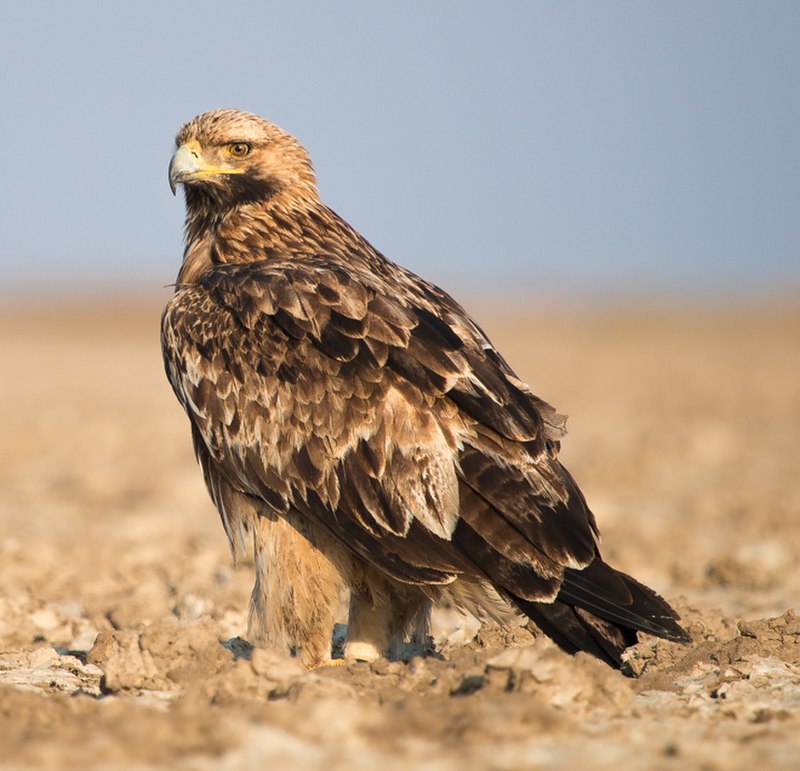
The Eastern Imperial Eagle is a majestic bird of prey, with striking features and sharp eyesight.
It breeds in southeastern Europe and throughout West and Central Asia, before migrating south to winter in Africa, the Middle East, or South/East Asia.
This eagle belongs to the Accipitridae family – known for their well-feathered legs – allowing them great agility when hunting their prey which includes rabbits, hares, and small mammals among other birds.
They have brown wings bordered by white feathers which gives it an elegant appearance that stands out from their environment.
In recent years there has been some concern about declining numbers due to loss of habitat or illegal poaching; however, conservation efforts are underway to ensure this beautiful species continues into future generations.
Scientific classification:
| Kingdom | Animalia |
| Phylum | Chordata |
| Class | Aves |
| Order | Accipitriformes |
| Family | Accipitridae |
| Genus | Aquila |
| Species | A. heliaca |
Also Featured In: Common Birds in Saudi Arabian, Imperial Birds You Should Know
25. Black-Bellied Bustard
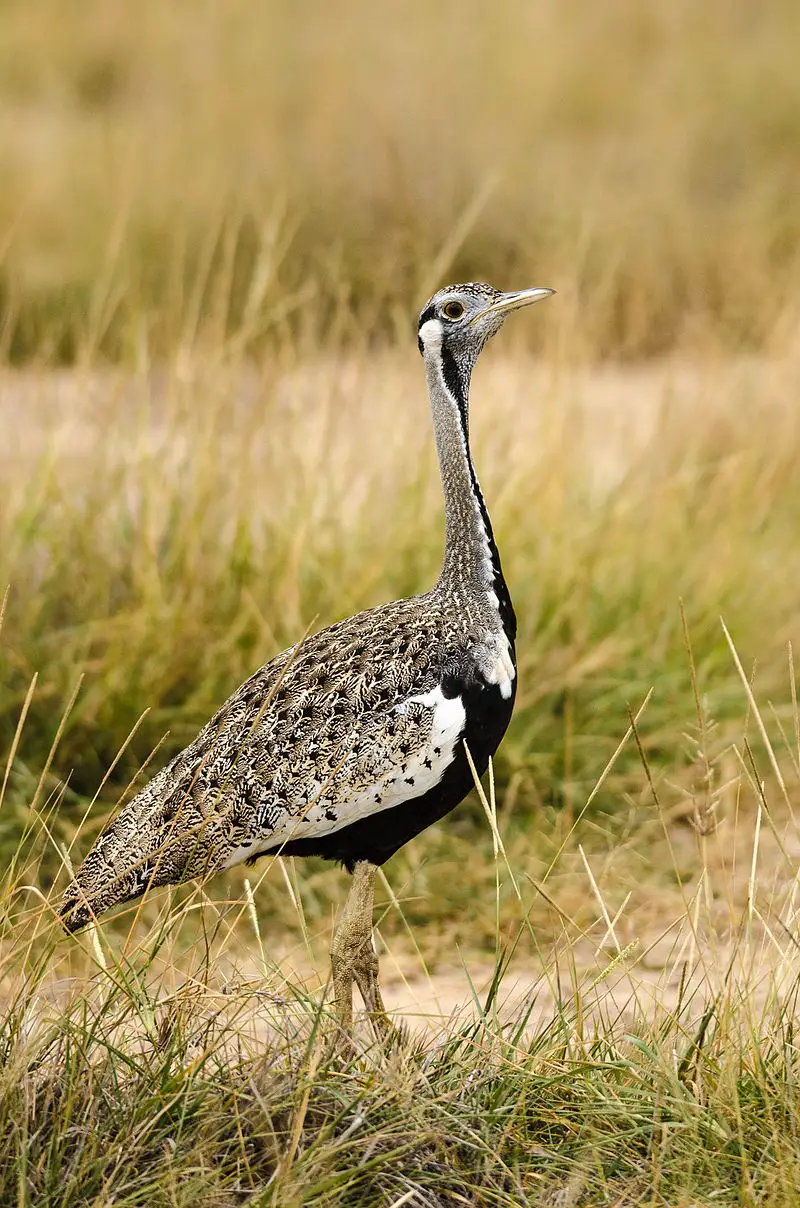
The black-bellied bustard is a fascinating bird, native to Africa. It belongs to the Bustard family and measures between 58–65 cm (23–26 in) long.
This beautiful creature has tawny buff upperparts with black and brown marks on it, while its underparts are entirely black.
Its head stands out due to bold patterns of white, buff, and black feathers which make for an impressive sight. The bill and legs of the Black-bellied Bustards have dull yellow coloration.
These birds live on the ground rather than in trees or bushes like other members of their species usually do – making them quite unique among African birds.
They can be found mostly in grasslands where they feed mainly on insects as well as small rodents occasionally too.
Scientific classification:
| Kingdom | Animalia |
| Phylum | Chordata |
| Class | Aves |
| Order | Otidiformes |
| Family | Otididae |
| Genus | Lissotis |
| Species | L. melanogaster |
Also Featured In: Most Unique Birds in Niger,
26. Steppe Eagle
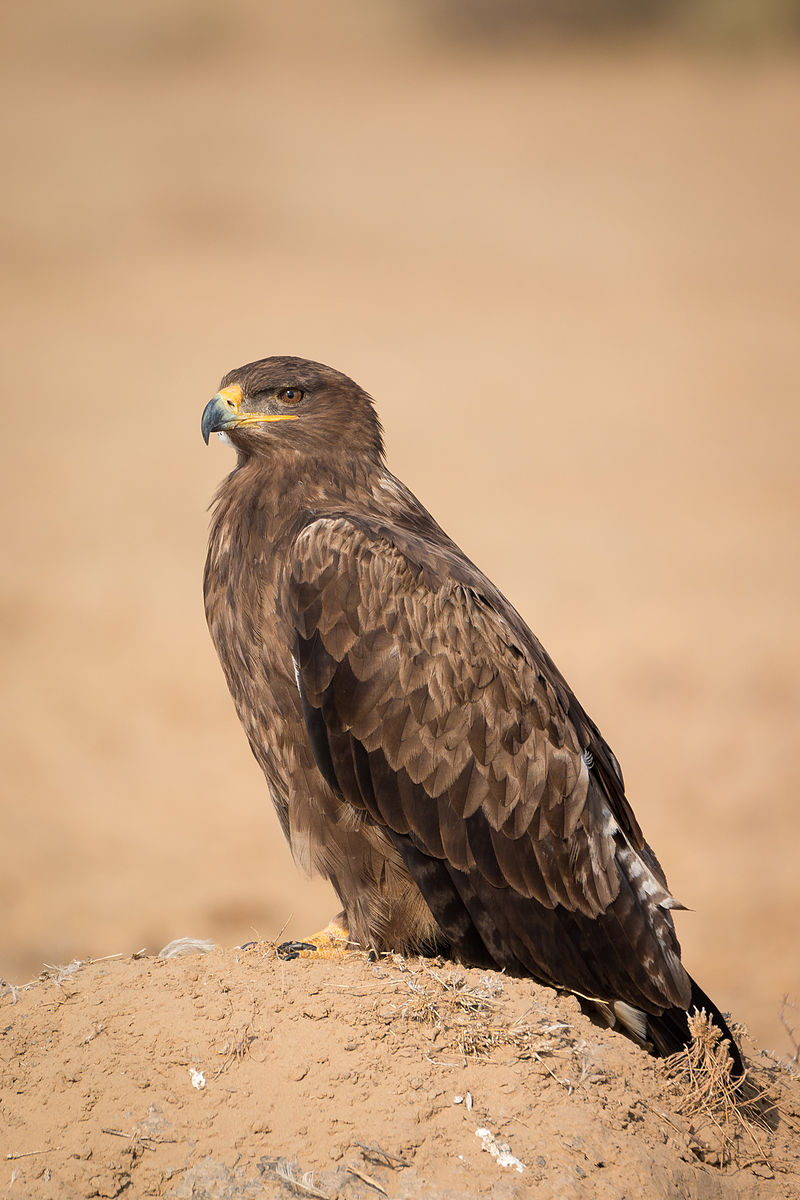
The Steppe eagle is a large bird of prey belonging to the family Accipitridae. With its well-feathered legs, it is classified as part of the subfamily Aquilinae or “booted eagles”.
It was once thought to be closely related to the Tawny Eagle but now they are considered distinct species.
This majestic creature has powerful talons used for catching and tearing apart their food such as small mammals and birds, reptiles, and amphibians.
They have an impressive wingspan usually measuring from 1 meter -1.5 meters in length with distinctive brownish plumage on top while having off-white coloring underneath them which helps camouflage itself when flying over open fields looking for their next meal.
The Steppe Eagles also build larger nests than other species up to 10 feet wide made out of twigs that provide safety and protection during breeding season.
Scientific classification:
| Kingdom | Animalia |
| Phylum | Chordata |
| Class | Aves |
| Order | Accipitriformes |
| Family | Accipitridae |
| Genus | Aquila |
| Species | A. nipalensis |
Also Featured In: Common Birds of the Jordan, Native Birds of Kazakhstan
27. Long-Legged Buzzard
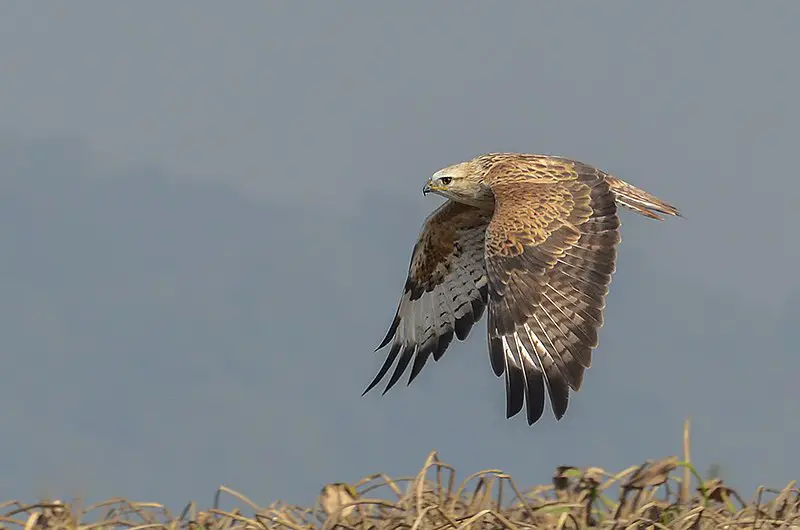
The Long-legged Buzzard is a large bird of prey found in many parts of Eurasia and North Africa.
It has long legs, which allows it to wade through shallow water or even snow when hunting for food.
The diet mainly consists of small mammals such as voles, but also includes amphibians, reptiles, and insects.
They are powerful birds that can fly up high into the sky with ease due to their wide wingspan.
This species is often seen soaring on thermals or hovering over open areas looking out for potential meals below them.
With its spectacular eyesight, they can spot prey from great distances away before swooping down quickly at incredible speeds to capture their meal.
Scientific classification:
| Kingdom | Animalia |
| Phylum | Chordata |
| Class | Aves |
| Order | Accipitriformes |
| Family | Accipitridae |
| Genus | Buteo |
| Species | B. rufinus |
Also Featured In: Birds of Israel, Armenian Birds You Should Know
28. Bearded Vulture
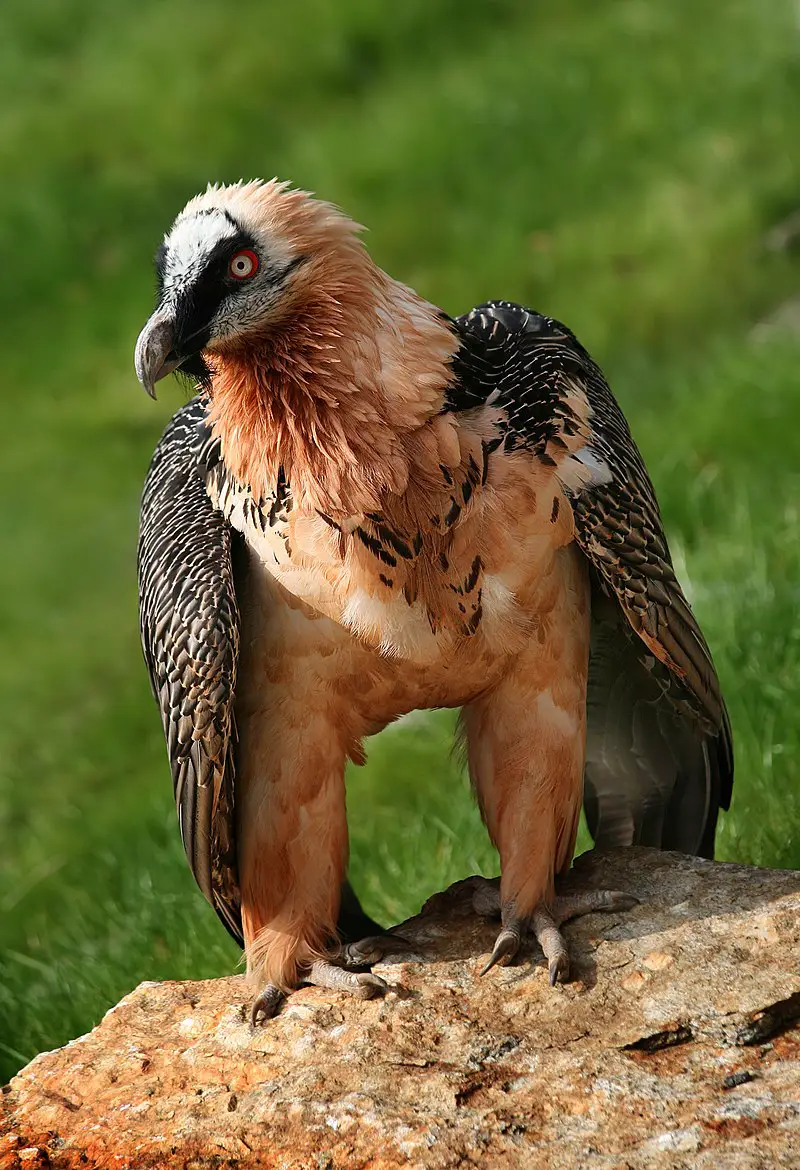
The Bearded vulture, also known as the lammergeier and ossifrage, is a majestic bird of prey belonging to its own genus within Accipitridae. It has an impressive wingspan that can reach up to 2.5m wide.
Its habitat ranges from Europe through Africa and into parts of Asia, where it prefers rocky areas with cliffs or mountainsides for nesting sites.
The bearded vulture’s diet consists mainly of carrion but it will occasionally feed on small mammals such as rabbits or hares too – using their powerful beak to crack open bones in order to get at the nutritious marrow inside.
These birds are highly endangered due primarily to human interference so conservation efforts must continue in order for us all to have them around for future generations.
Scientific classification:
| Kingdom | Animalia |
| Phylum | Chordata |
| Class | Aves |
| Order | Accipitriformes |
| Family | Accipitridae |
| Genus | Gypaetus Storr, 1784 |
| Species | G. barbatus |
Also Featured In: Common Birds Found in Switzerland, Birds that Live in the Deserts
29. Tufted Duck
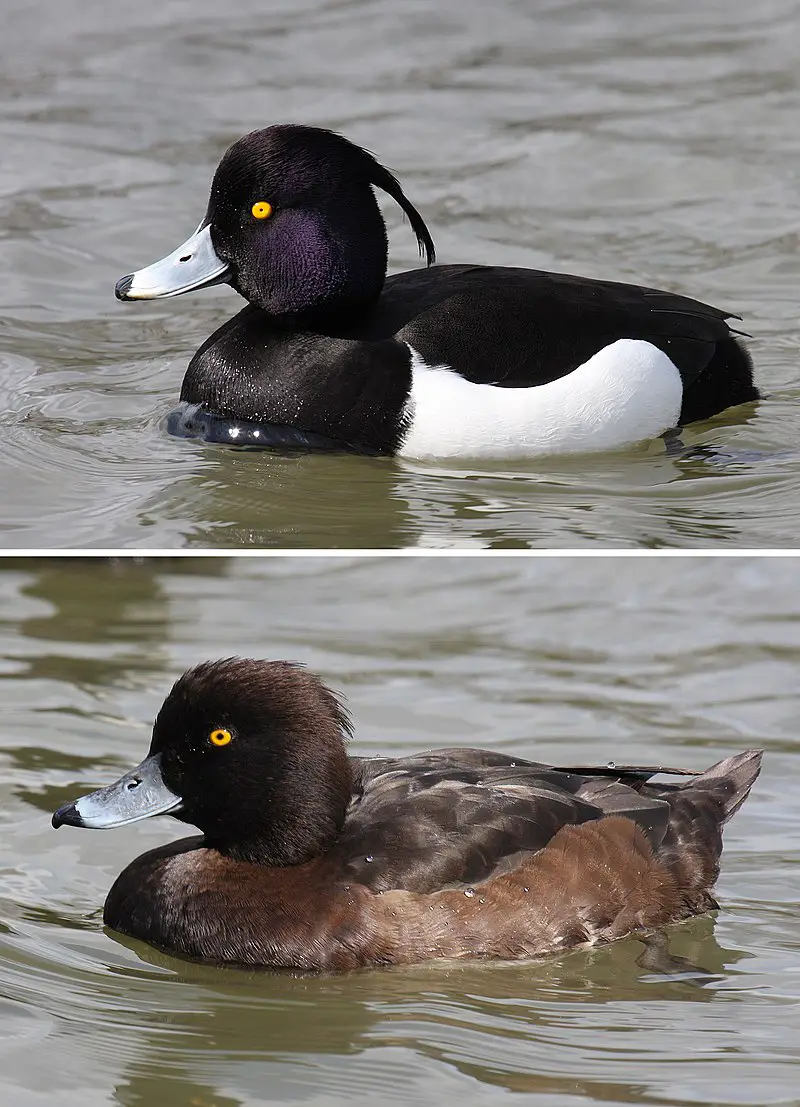
The Tufted Duck is a small diving duck that can be found in northern Eurasia, with an estimated population of nearly one million. It gets its scientific name from Ancient Greek and Latin words meaning “sooty throat”.
The adult male has black plumage except for white flanks and a blue-grey bill. Its head is also adorned by the distinctive tufts that give it its common name.
Females are brownish grey on their upper parts and have paler underparts than males as well as having orange bills instead of blue-grey ones like their male counterparts.
This species feeds mainly on aquatic plants but will occasionally eat molluscs, crustaceans, insects, or worms when they’re available too.
They are generally quite shy birds so keep your distance if you spot them while out in nature to avoid disturbing them unnecessarily
Scientific classification:
| Kingdom | Animalia |
| Phylum | Chordata |
| Class | Aves |
| Order | Anseriformes |
| Family | Anatidae |
| Genus | Aythya |
| Species | A. fuligula |
Also Featured In: Kuwait Birds, Common Birds of Maharashtra
30. African Fish Eagle
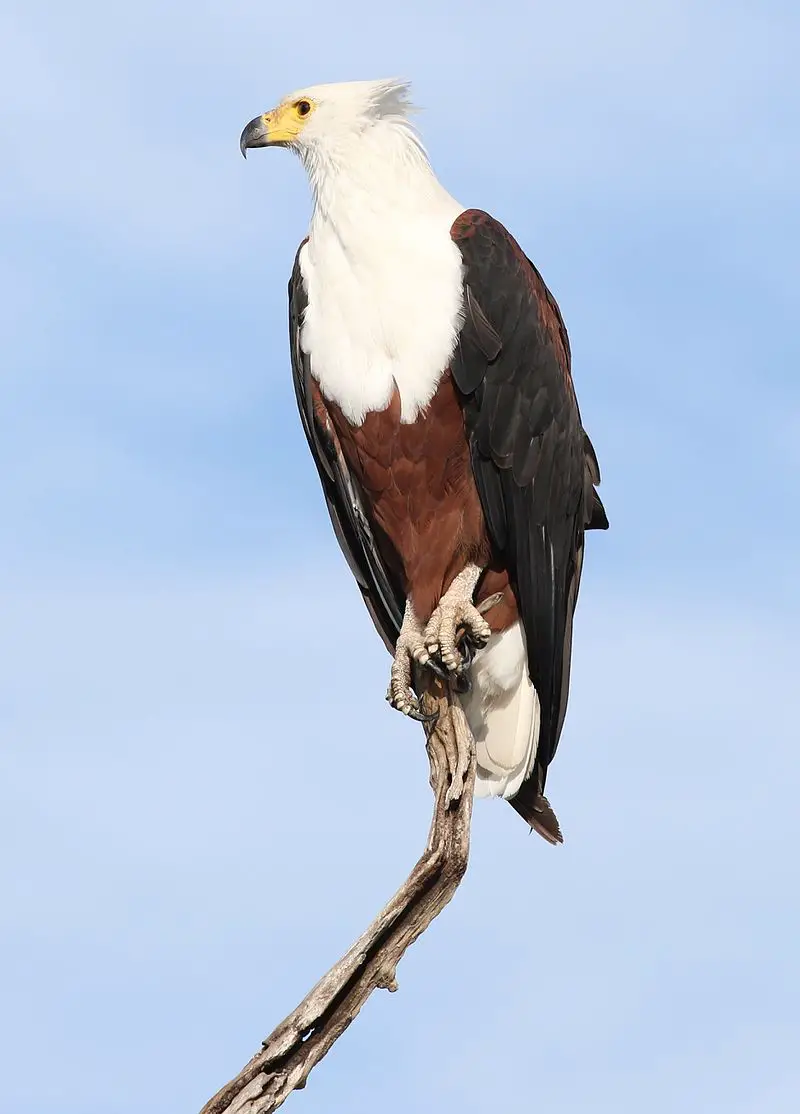
The African fish eagle is a majestic bird of prey found in sub-Saharan Africa near large bodies of water. It is known by many names in different languages due to its extensive range.
This eagle is the national bird of four African countries, including Malawi, Namibia, Zambia, and Zimbabwe.
Its scientific name, Haliaeetus vocifer, is fitting because it has a loud, distinctive call that can be heard from quite a distance.
The African fish eagle’s diet consists mainly of fish, which it swoops down to catch with its talons while in flight.
Its distinctive brown and white plumage, hooked beak, and sharp talons make this a formidable and impressive hunter.
The African fish eagle is an important symbol of African wildlife and is admired by bird watchers and nature enthusiasts for its beauty and strength.
Scientific classification:
| Kingdom | Animalia |
| Phylum | Chordata |
| Class | Aves |
| Order | Accipitriformes |
| Family | Accipitridae |
| Genus | Haliaeetus |
| Species | H. vocifer |
Also Featured In: African Birds, Savanna Birds You Need to See
31. Grey-Crested Helmetshrike
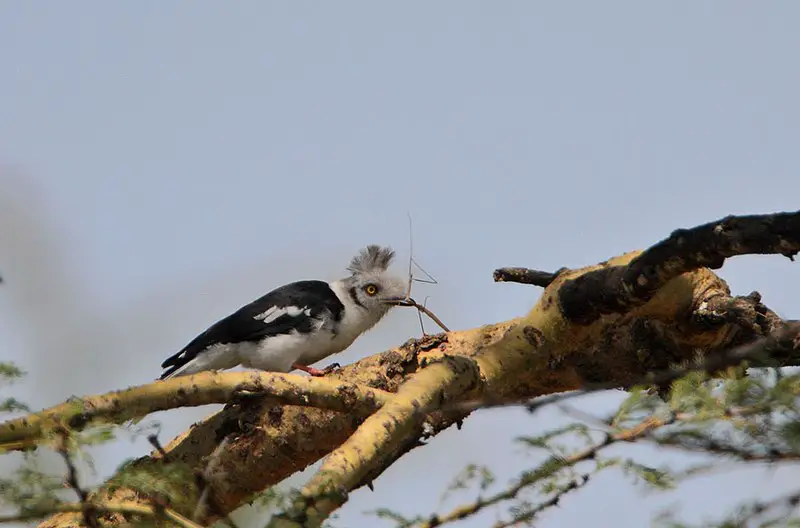
The Grey-crested helmetshrike, also known as Prionops poliolophus, is a bird species belonging to the Vanga family of birds.
This bird is commonly found in the regions of Kenya and Tanzania, where its natural habitat comprises dry savanna and subtropical or tropical dry shrubland.
The Grey-crested helmetshrike is at risk of extinction due to the gradual loss of its natural habitat.
Previously classified under the Malaconotidae family, this bird has been studied and researched over the years.
The bird’s distinct features include a grey head with a black crest and a white throat with a black patch below.
Although beautiful in appearance, this bird is facing numerous threats and needs protection to prevent it from becoming extinct.
Scientific classification:
| Kingdom | Animalia |
| Phylum | Chordata |
| Class | Aves |
| Order | Passeriformes |
| Family | Vangidae |
| Genus | Prionops |
| Species | P. poliolophus |
32. Black-Cheeked Waxbill
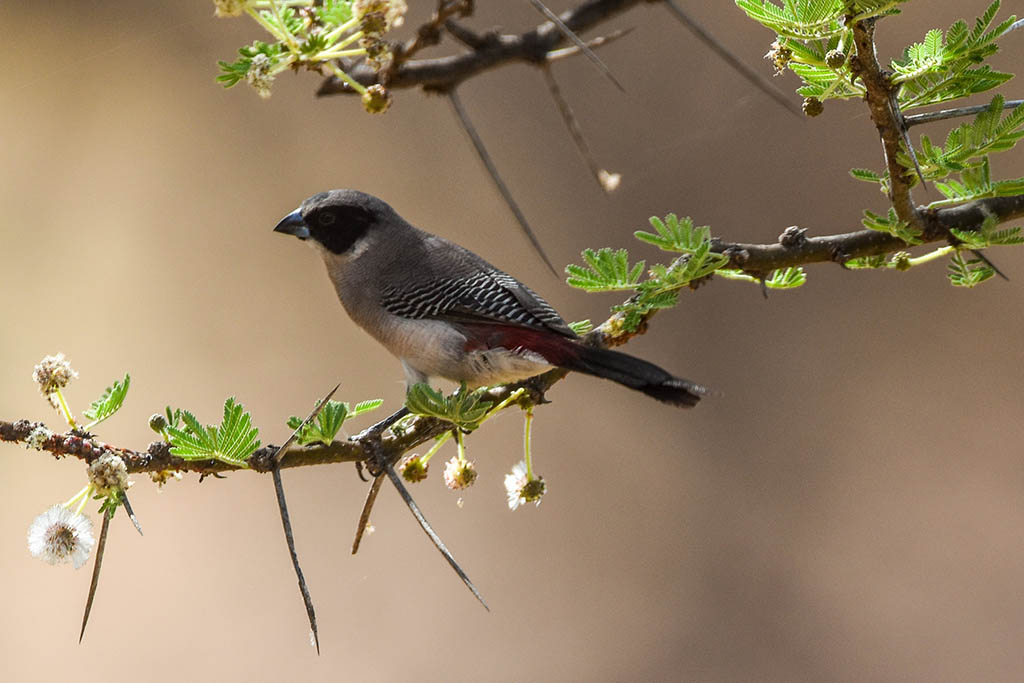
The black-cheeked waxbill, also known as the red-rumped waxbill, is a type of finch found in eastern Africa.
It has a wide range, estimated to cover 400,000 square kilometers across Ethiopia, Kenya, Somalia, South Sudan, and Tanzania.
Despite being a common species, the black-cheeked waxbill is evaluated as “Least Concern” in terms of its conservation status.
It is known for its striking black cheeks and reddish-brown rump and is often kept as a pet. Like other waxbills, it feeds primarily on seeds and insects.
Despite its widespread distribution, little is known about the behavior and ecology of this bird in the wild.
Scientific classification:
| Kingdom | Animalia |
| Phylum | Chordata |
| Class | Aves |
| Order | Passeriformes |
| Family | Estrildidae |
| Genus | Brunhilda |
| Species | B. charmosyna |
33. Baglafecht Weaver
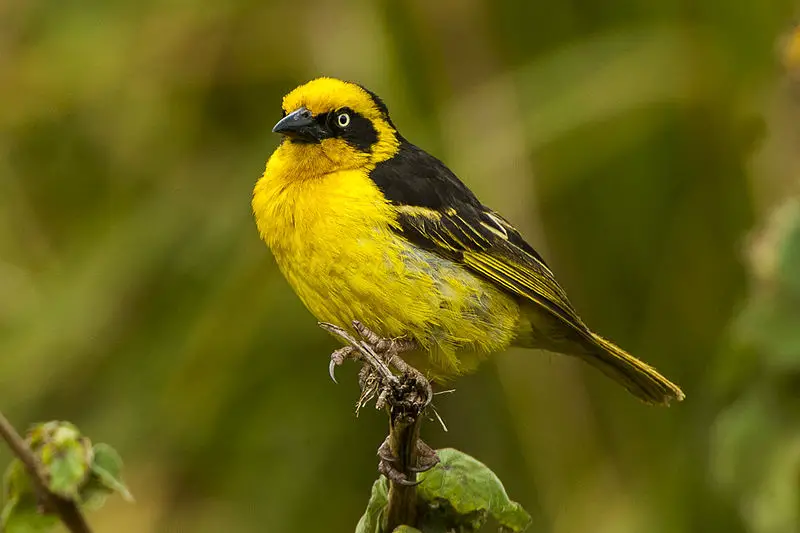
The Baglafecht weaver bird is a member of the Ploceidae family that can be found in central and eastern Africa.
It has several different races with unique feather patterns, and some of these races display a distinct non-breeding plumage.
The name “baglafecht” was created by Georges-Louis Leclerc, Comte de Buffon, and its origin is unclear.
This bird displays strong weaving abilities, constructing complex and intricate nests from grasses and other materials. It is a sociable bird, often found in flocks that can number in the thousands.
While not currently considered endangered, habitat loss and fragmentation may pose a threat to the long-term survival of the Baglafecht weaver bird.
Scientific classification:
| Kingdom | Animalia |
| Phylum | Chordata |
| Class | Aves |
| Order | Passeriformes |
| Family | Ploceidae |
| Genus | Ploceus |
| Species | P. baglafecht |
34. Eastern Golden Weaver
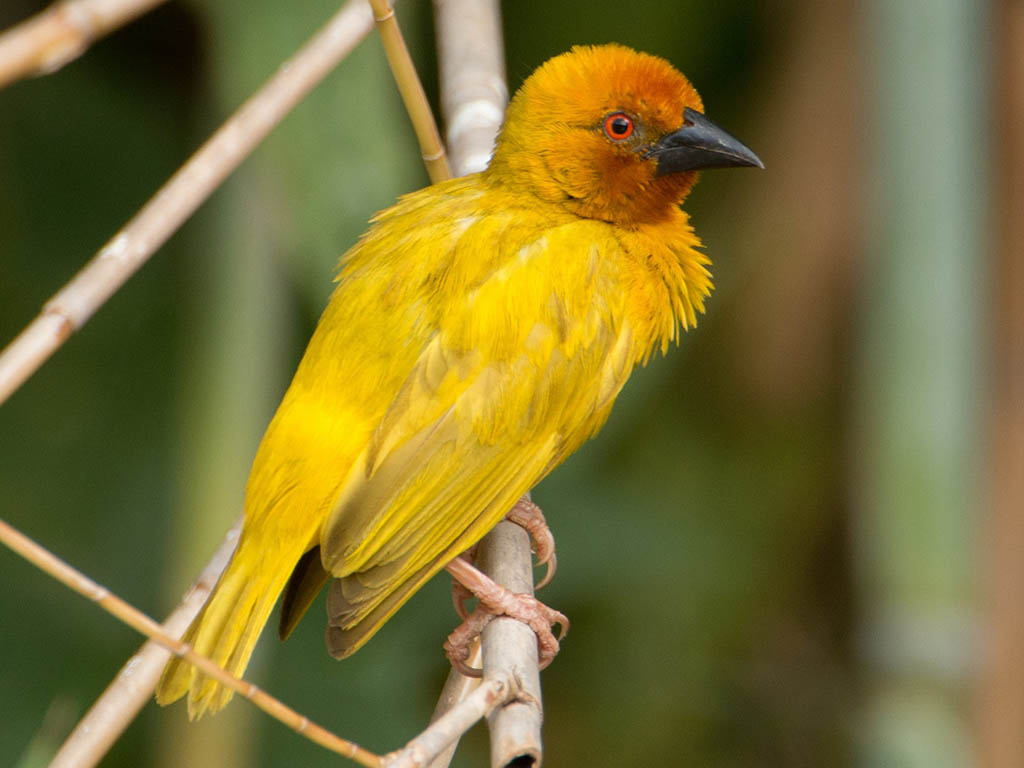
The Eastern golden weaver is a bird species belonging to the Ploceidae family. This bird is found in eastern and south-eastern regions of Africa.
It is also known as the yellow weaver, olive-headed golden weaver, and African golden weaver.
The Eastern golden weaver has a distinct bright yellow-golden color and an olive-colored head. It loves to build nests in trees, usually near water sources.
The Eastern golden weaver also has a peculiar behavior of weaving long, elaborate nests that hang like lanterns.
These nests are woven solely by the males during the breeding season to attract females. Their primary diet includes seeds and insects.
The Eastern golden weaver is a magnificent bird species known for its unique nest-building behavior and beautiful appearance.
Scientific classification:
| Kingdom | Animalia |
| Phylum | Chordata |
| Class | Aves |
| Order | Passeriformes |
| Family | Ploceidae |
| Genus | Ploceus |
| Species | P. subaureus |
Conclusion
The East African region is home to a remarkable diversity of bird species, with 34 distinct and fascinating avian residents. These birds inhabit a variety of ecosystems, from lush forests to arid savannas, showcasing the region’s rich biodiversity.
East Africa’s unique geographical features and climate contribute to the coexistence of such a diverse range of birdlife.
Conservation efforts are essential to protect these species and their habitats, as they play crucial roles in maintaining ecological balance and providing numerous benefits to the ecosystem.
Studying and appreciating these East African birds not only enriches our understanding of nature but also underscores the importance of preserving their habitats for future generations to enjoy and learn from.